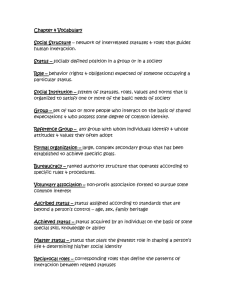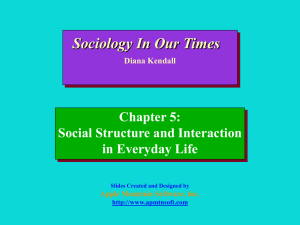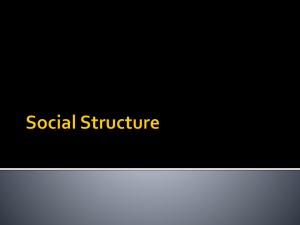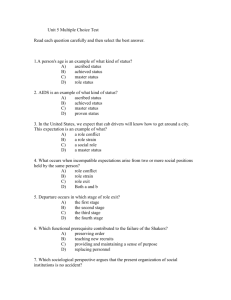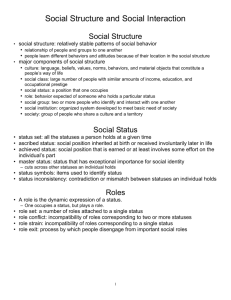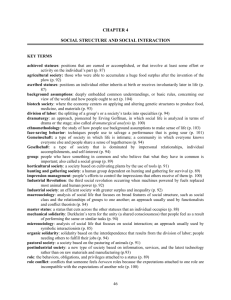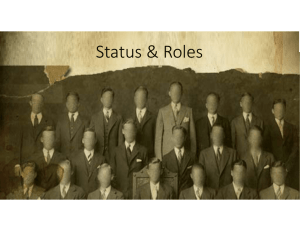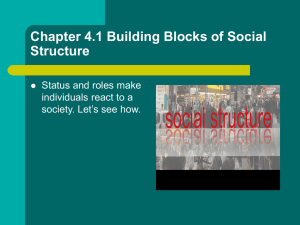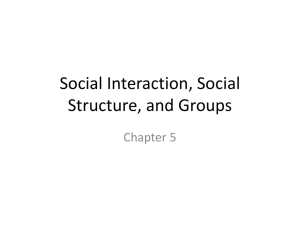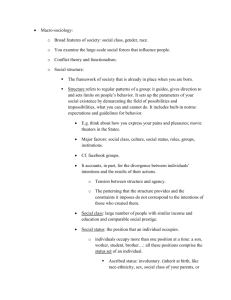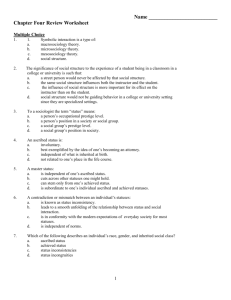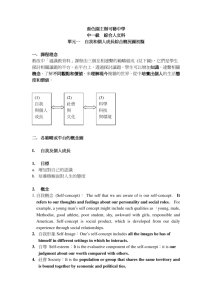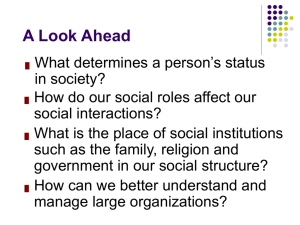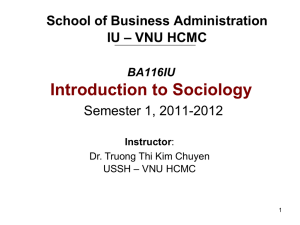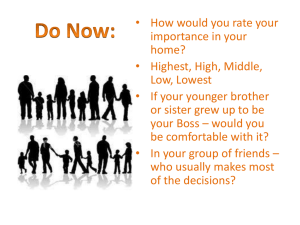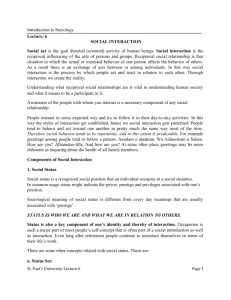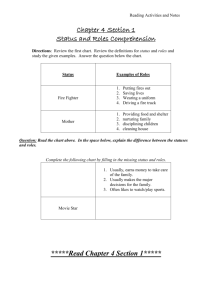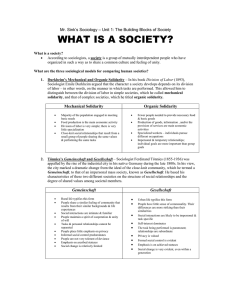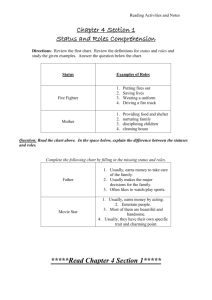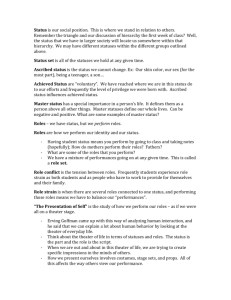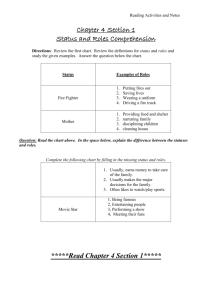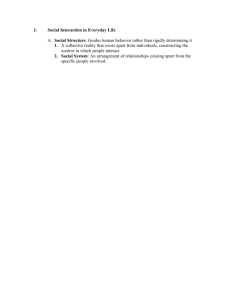Chapter five Sociology
advertisement
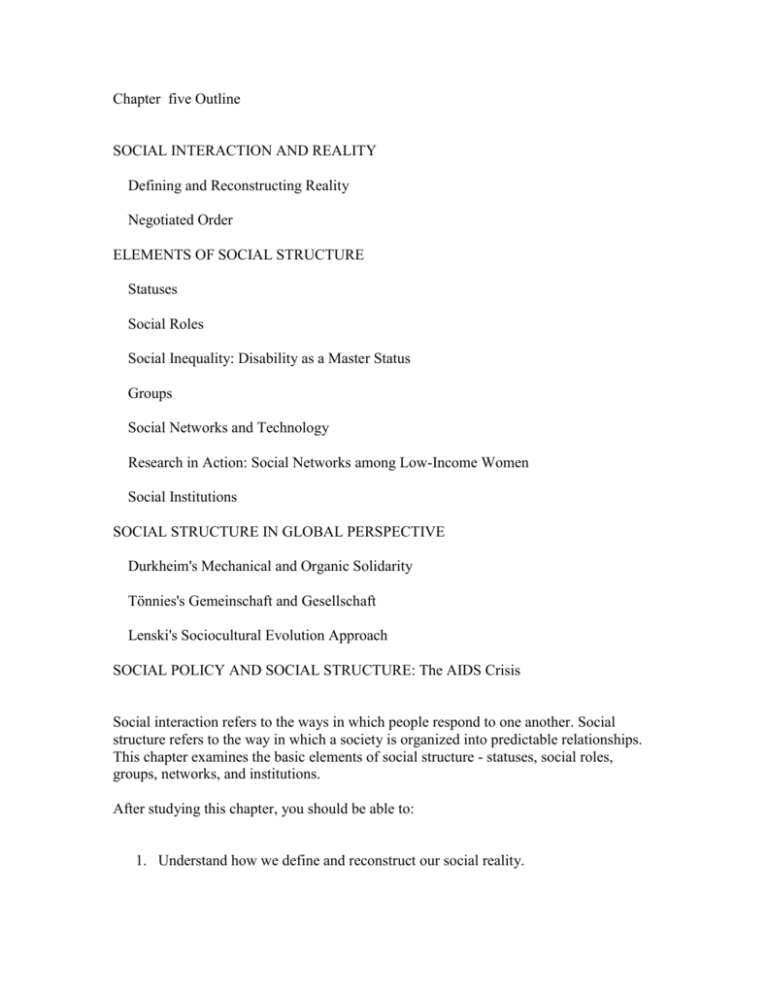
Chapter five Outline SOCIAL INTERACTION AND REALITY Defining and Reconstructing Reality Negotiated Order ELEMENTS OF SOCIAL STRUCTURE Statuses Social Roles Social Inequality: Disability as a Master Status Groups Social Networks and Technology Research in Action: Social Networks among Low-Income Women Social Institutions SOCIAL STRUCTURE IN GLOBAL PERSPECTIVE Durkheim's Mechanical and Organic Solidarity Tönnies's Gemeinschaft and Gesellschaft Lenski's Sociocultural Evolution Approach SOCIAL POLICY AND SOCIAL STRUCTURE: The AIDS Crisis Social interaction refers to the ways in which people respond to one another. Social structure refers to the way in which a society is organized into predictable relationships. This chapter examines the basic elements of social structure - statuses, social roles, groups, networks, and institutions. After studying this chapter, you should be able to: 1. Understand how we define and reconstruct our social reality. 2. Give your own examples of ascribed, achieved, and master statuses. 3. Discuss the social roles we acquire throughout our lives. 4. Differentiate between role conflict, role strain, and role exit. 5. List the four stages of role exit identified by Helen Rose Fuchs Ebaugh. 6. Explain what is meant by the term social network. 7. Contrast the functionalist, conflict, and interactionist views of social institutions. 8. Summarize the differences between the Gemeinschaft and the Gesellschaft community. 9. Discuss Gerhard Lenski's sociocultural evolution approach. 10. Describe the characteristics of the hunting-and-gathering society, the horticultural society, the industrial society, and the postindustrial and postmodern society. 11. Summarize the concerns about the AIDS crisis from the interactionist perspective. Chapter Summary Social interaction refers to the ways in which people respond to one another. Social structure refers to the way in which a society is organized into predictable relationships. This chapter examines the basic elements of social structure: statuses, social roles, groups, networks, and institutions. 1. We shape our social reality based on what we learn through our social interactions. Social change comes from redefining or reconstructing social reality. Sometimes change results from negotiation. 2. An ascribed status is generally assigned to a person at birth, whereas an achieved status is attained largely through one's own effort. 3. In the United States, ascribed statuses, such as race and gender, can function as master statuses that have an important impact on one's potential to achieve a desired professional and social status. 4. With each distinctive status-whether ascribed or achieved-come particular social roles, the set of expectations for people who occupy that status. 5. Much of our patterned behavior takes place within groups and is influenced by the norms and sanctions established by groups. Groups serve as links to social networks and their vast resources. 6. The mass media, the government, the economy, the family, and the health care system are all examples of social institutions found in the United States. 7. One way to understand social institutions is to ask how they fulfill essential functions, such as replacing personnel, training new recruits, and preserving order. 8. Conflict theorists argue that social institutions help to maintain the privileges of the powerful while contributing to the powerlessness of others. 9. Interactionist theorists emphasize the idea that our social behavior is conditioned by the roles and statuses that we accept, the groups to which we belong, and the institutions within which we function. 10. Émile Durkheim thought that social structure depends on the division of labor in a society. According to Durkheim's theory, societies with minimal division of labor have a collective consciousness called mechanical solidarity; those with greater division of labor show an interdependence called organic solidarity. 11. Ferdinand Tönnies distinguished the close-knit community of Gemeinschaft from the impersonal mass society known as Gesellschaft. 12. Gerhard Lenski thinks that a society's social structure changes as its culture and technology become more sophisticated, a process he calls sociocultural evolution. 13. The AIDS crisis has changed our society's social structure, prompting the creation of new networks to care for the ill and educate the healthy. Policymakers were slow to respond to the crisis at first because the high-risk groups the disease affected were relatively powerless.
